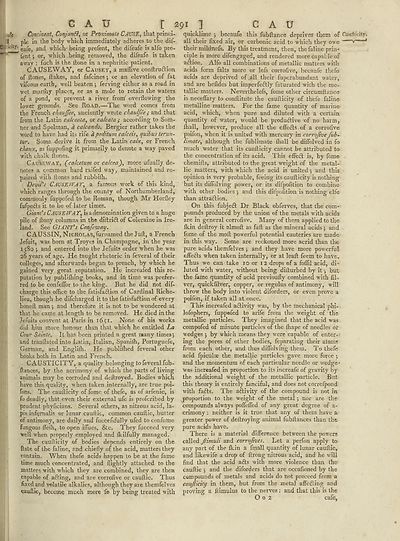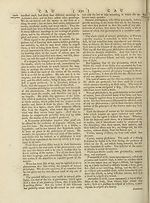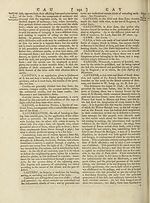Encyclopaedia Britannica, or, a Dictionary of arts, sciences, and miscellaneous literature : enlarged and improved. Illustrated with nearly six hundred engravings > Volume 5, BUR-CHI
(309) Page 291
Download files
Complete book:
Individual page:
Thumbnail gallery: Grid view | List view

C A U t 291 ] C A U
ufe Continent, Conjunct, or Proximate CAUSE, that princi-
II pie in the body which immediately adheres to the dif-
iclty-, eafe, and which" being prefent, the dii’eafe is alfo pre-
' fent •, or, which being removed, the difeafe is taken
away : fuch is the ftone in a nephritic patient.
CAUSEWAY, or Causey, a maflive conftruftion
of itones, flakes, and fafcines; or an elevation of fat
vifeous earth, well beaten •, ferving either as a road in
wet marfliy places, or as a mole to retain the waters
of a pond, or prevent a river from overflowing the
lower grounds. See Road.—The word comes from
the French chaujjee, anciently wrote chaulfee ; and that
from the Latin calceala, or calcata ; according to Som-
ner and Spelman, a calcando. Bergier rather takes the
word to have had its rife apeditum ca'ceis, quibus terun-
tur. Some derive it from the Latin calx, or French
chaux, as fuppoiing it primarily to denote a way paved
with chalk ftones.
Causeway, (calcetum or calcea), more ufually de¬
notes a common hard raifed way, maintained and re¬
paired with ftones and rubbiftv.
Devil's CAUSE lFA r, a famous work of this kind,
which ranges through the county of Northumberland,
commonly fuppofed to be Roman, though Mr Horfley
fufpefts it to be of later times.
Giant's CAUSEWAY, is a denomination given to a huge
pile of ftony columns in the diftrift of Coleraine in Ire¬
land. See GlANT's Caufeway.
CAUSSIN, Nicholas, furnamed the Juft, a French
Jefuit, was born at Troyes in Champagne, in the year
1580 j and entered into the Jefuits order when he was
26 years of age. He taught rhetoric in feveral of their
colleges, and afterwards began to preach, by which he
gained very great reputation. Fie increafed this re¬
putation by publiftiing books, and in time was prefer¬
red to be confeflbr to the king. But he did Hot dif-
charge this office to the fatisfa&ion of Cardinal Riche¬
lieu, though he difcharged it to the fatisfaftion of every
honeft man •, and therefore it is not to be wondered at
that he came at length to be removed. He died in the
Jefuits convent at Paris in i6f[i. None of his works
did him more honour than that which he entitled La
Cour Sainte. It has been printed a great many times $
and tranflated into Latin, Italian, Spaniffi, Portuguefe,
German, and Engliffi. He publifhed feveral other
books both in Latin and French.
CAUSTICITY, a quality belonging to feveral fub-
ftances, by the acrimony of which the parts of living
animals may be corroded and deftroyed. Bodies which
have this quality, when taken internally, are true poi-
fons. The caufticity of fome of thefe, as of arfenic, is
fo deadly, that even their external ufe is profcribed by
prudent phyficians. Several others, as nitrous acid, la¬
pis inf^malis or lunar cauftic, common cauftic, butter
of antimony, are daily and fuccefsfully ufed to confume
fungous fleffi, to open iffues, &c. They fucceed very
Well when properly employed and fkilfully managed.
The caufticity of bodies depends entirely on the
ftate of the faline, and chiefly of the acid, matters they
contain. When thefe acids happen to be at the fame
time much concentrated, and {lightly attached to the
matters with which they are combined, they are then
capable of afting, and are corrofive or cauftic. Thus
fixed and volatile alkalies, although they are themfelves
cauftic, become much more fo by being treated with
quicklime j becaufe this fubftance deprives them of Caufticity.
all their fixed air, or carbonic acid to which they owe
their mildnefs. By this treatment, then, the faline prin¬
ciple is more difengaged, and rendered more capable of
action. Alfo all combinations of metallic matters with
acids form falts more or lefs corrofive, becaufe thefo
acids are deprived of .all their fuperabundant water,
and are befides but imperfeflly faturated with the me¬
tallic matters. Neverthelefs, fome other circumltance
is neceflary to conftitute the caufticity of thefe faline
metalline matters. For the fame quantity of marine
acid, which, v-hen pure and diluted with a certain
quantity of Water, would be produftive of no harm,
{hall, however, produce all the effe&s.of a corrolive
poifon, when it is united with mercury in corrojive fnb-
hmate, although the fublimate (ball be difiblved in fo
much water that its caufticity cannot be attributed to
the concentration of its acid. This effeft is, by fome
chemifts, attributed to the great weight of the metal¬
lic matters, with which the acid is united ; and this
opinion is very probable, feeing its caufticity is nothing
but its diffolving power, or its difpofition to combine
with other bodies j and this difpofition is nothing elfe
than attraction.
On this fubjeft Dr Black obferves, that the com¬
pounds produced by the union of the metals with acids
are in general corrofive. Many of them applied to the
{kin deftroy it almoft as fail as the mineral acids $ and
fome of the moft powerful potential cauteries are made
in this way. Some are reckoned more acrid than the
pure acids themfelves j and they have more powerful
effefts when taken internally, or at leaft feem to have.
Thus we can take 10 or 12 drops of a foflil acid, di ¬
luted with water, without being difturbed by it j but
the fame quantity of acid previoufly combined with fil-
ver, quickfilver, copper, or regulus of antimony, will
throw the body into violent diforders, or even prove a
poifon, if taken all at once.
This increafed adivity was, by the mechanical phi-
lofophers, fuppefed to arife from the weight of the
metallic particles. They imagined that the acid was
compofed of minute particles of the flrape of needles or
wedges j by which means they were capable of enter¬
ing the pores of other bodies, feparating their atom?
from each other, and thus diffolving them. To thefe
acid fpiculce the metallic particles gave more force $
and the momentum of each particular needle or wedge-
was increafed in proportion to its increafe of gravity by
the additional weight of the metallic particle. But
this theory is entirely fanciful, and does not correlpond
with fafls. The activity of the compound is not in
proportion to the weight of the metal j nor are the
compounds always poffeffed of any great degree of a-
crimony : neither is it true that any of them, have a
greater power of deftroy ing animal fubftances than the
pure acids have.
There is a material difference between the powers
called Jlimuli and corrojives. Let a perfon apply to
any part of the {kin a fmall quantity of lunar cauftic,
and likewife a drop of ftrong nitrous acid, and he will
find that the acid a£ts with more violence than the
cauftic 5 and the diforders that are occafioned by the
compounds of metals and acids do not proceed from a
caujlicity in them, but from the metal affe&ing and
proving a famulus to the nerves : and that this is the
O o 2 cafe,
ufe Continent, Conjunct, or Proximate CAUSE, that princi-
II pie in the body which immediately adheres to the dif-
iclty-, eafe, and which" being prefent, the dii’eafe is alfo pre-
' fent •, or, which being removed, the difeafe is taken
away : fuch is the ftone in a nephritic patient.
CAUSEWAY, or Causey, a maflive conftruftion
of itones, flakes, and fafcines; or an elevation of fat
vifeous earth, well beaten •, ferving either as a road in
wet marfliy places, or as a mole to retain the waters
of a pond, or prevent a river from overflowing the
lower grounds. See Road.—The word comes from
the French chaujjee, anciently wrote chaulfee ; and that
from the Latin calceala, or calcata ; according to Som-
ner and Spelman, a calcando. Bergier rather takes the
word to have had its rife apeditum ca'ceis, quibus terun-
tur. Some derive it from the Latin calx, or French
chaux, as fuppoiing it primarily to denote a way paved
with chalk ftones.
Causeway, (calcetum or calcea), more ufually de¬
notes a common hard raifed way, maintained and re¬
paired with ftones and rubbiftv.
Devil's CAUSE lFA r, a famous work of this kind,
which ranges through the county of Northumberland,
commonly fuppofed to be Roman, though Mr Horfley
fufpefts it to be of later times.
Giant's CAUSEWAY, is a denomination given to a huge
pile of ftony columns in the diftrift of Coleraine in Ire¬
land. See GlANT's Caufeway.
CAUSSIN, Nicholas, furnamed the Juft, a French
Jefuit, was born at Troyes in Champagne, in the year
1580 j and entered into the Jefuits order when he was
26 years of age. He taught rhetoric in feveral of their
colleges, and afterwards began to preach, by which he
gained very great reputation. Fie increafed this re¬
putation by publiftiing books, and in time was prefer¬
red to be confeflbr to the king. But he did Hot dif-
charge this office to the fatisfa&ion of Cardinal Riche¬
lieu, though he difcharged it to the fatisfaftion of every
honeft man •, and therefore it is not to be wondered at
that he came at length to be removed. He died in the
Jefuits convent at Paris in i6f[i. None of his works
did him more honour than that which he entitled La
Cour Sainte. It has been printed a great many times $
and tranflated into Latin, Italian, Spaniffi, Portuguefe,
German, and Engliffi. He publifhed feveral other
books both in Latin and French.
CAUSTICITY, a quality belonging to feveral fub-
ftances, by the acrimony of which the parts of living
animals may be corroded and deftroyed. Bodies which
have this quality, when taken internally, are true poi-
fons. The caufticity of fome of thefe, as of arfenic, is
fo deadly, that even their external ufe is profcribed by
prudent phyficians. Several others, as nitrous acid, la¬
pis inf^malis or lunar cauftic, common cauftic, butter
of antimony, are daily and fuccefsfully ufed to confume
fungous fleffi, to open iffues, &c. They fucceed very
Well when properly employed and fkilfully managed.
The caufticity of bodies depends entirely on the
ftate of the faline, and chiefly of the acid, matters they
contain. When thefe acids happen to be at the fame
time much concentrated, and {lightly attached to the
matters with which they are combined, they are then
capable of afting, and are corrofive or cauftic. Thus
fixed and volatile alkalies, although they are themfelves
cauftic, become much more fo by being treated with
quicklime j becaufe this fubftance deprives them of Caufticity.
all their fixed air, or carbonic acid to which they owe
their mildnefs. By this treatment, then, the faline prin¬
ciple is more difengaged, and rendered more capable of
action. Alfo all combinations of metallic matters with
acids form falts more or lefs corrofive, becaufe thefo
acids are deprived of .all their fuperabundant water,
and are befides but imperfeflly faturated with the me¬
tallic matters. Neverthelefs, fome other circumltance
is neceflary to conftitute the caufticity of thefe faline
metalline matters. For the fame quantity of marine
acid, which, v-hen pure and diluted with a certain
quantity of Water, would be produftive of no harm,
{hall, however, produce all the effe&s.of a corrolive
poifon, when it is united with mercury in corrojive fnb-
hmate, although the fublimate (ball be difiblved in fo
much water that its caufticity cannot be attributed to
the concentration of its acid. This effeft is, by fome
chemifts, attributed to the great weight of the metal¬
lic matters, with which the acid is united ; and this
opinion is very probable, feeing its caufticity is nothing
but its diffolving power, or its difpofition to combine
with other bodies j and this difpofition is nothing elfe
than attraction.
On this fubjeft Dr Black obferves, that the com¬
pounds produced by the union of the metals with acids
are in general corrofive. Many of them applied to the
{kin deftroy it almoft as fail as the mineral acids $ and
fome of the moft powerful potential cauteries are made
in this way. Some are reckoned more acrid than the
pure acids themfelves j and they have more powerful
effefts when taken internally, or at leaft feem to have.
Thus we can take 10 or 12 drops of a foflil acid, di ¬
luted with water, without being difturbed by it j but
the fame quantity of acid previoufly combined with fil-
ver, quickfilver, copper, or regulus of antimony, will
throw the body into violent diforders, or even prove a
poifon, if taken all at once.
This increafed adivity was, by the mechanical phi-
lofophers, fuppefed to arife from the weight of the
metallic particles. They imagined that the acid was
compofed of minute particles of the flrape of needles or
wedges j by which means they were capable of enter¬
ing the pores of other bodies, feparating their atom?
from each other, and thus diffolving them. To thefe
acid fpiculce the metallic particles gave more force $
and the momentum of each particular needle or wedge-
was increafed in proportion to its increafe of gravity by
the additional weight of the metallic particle. But
this theory is entirely fanciful, and does not correlpond
with fafls. The activity of the compound is not in
proportion to the weight of the metal j nor are the
compounds always poffeffed of any great degree of a-
crimony : neither is it true that any of them, have a
greater power of deftroy ing animal fubftances than the
pure acids have.
There is a material difference between the powers
called Jlimuli and corrojives. Let a perfon apply to
any part of the {kin a fmall quantity of lunar cauftic,
and likewife a drop of ftrong nitrous acid, and he will
find that the acid a£ts with more violence than the
cauftic 5 and the diforders that are occafioned by the
compounds of metals and acids do not proceed from a
caujlicity in them, but from the metal affe&ing and
proving a famulus to the nerves : and that this is the
O o 2 cafe,
Set display mode to:
![]() Universal Viewer |
Universal Viewer | ![]() Mirador |
Large image | Transcription
Mirador |
Large image | Transcription
Images and transcriptions on this page, including medium image downloads, may be used under the Creative Commons Attribution 4.0 International Licence unless otherwise stated. ![]()
| Permanent URL | https://digital.nls.uk/192988286 |
|---|
| Attribution and copyright: |
|
|---|
| Description | Ten editions of 'Encyclopaedia Britannica', issued from 1768-1903, in 231 volumes. Originally issued in 100 weekly parts (3 volumes) between 1768 and 1771 by publishers: Colin Macfarquhar and Andrew Bell (Edinburgh); editor: William Smellie: engraver: Andrew Bell. Expanded editions in the 19th century featured more volumes and contributions from leading experts in their fields. Managed and published in Edinburgh up to the 9th edition (25 volumes, from 1875-1889); the 10th edition (1902-1903) re-issued the 9th edition, with 11 supplementary volumes. |
|---|---|
| Additional NLS resources: |
|

